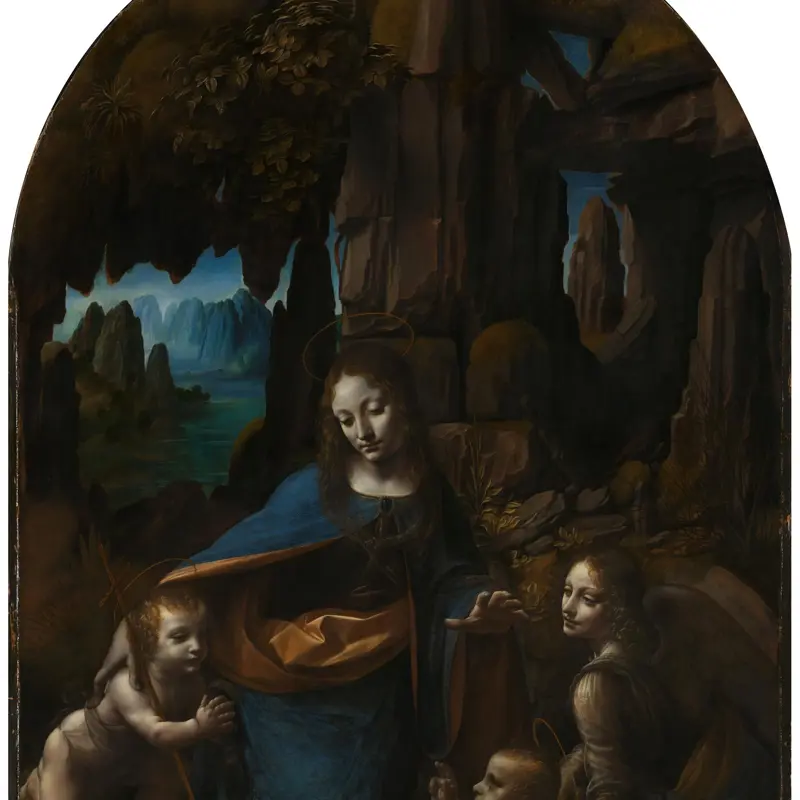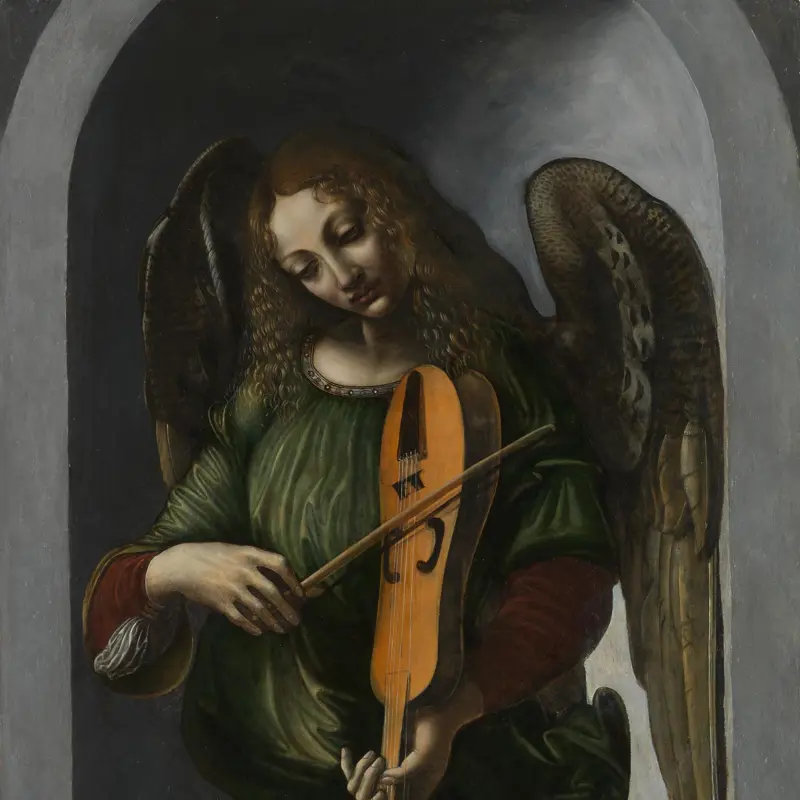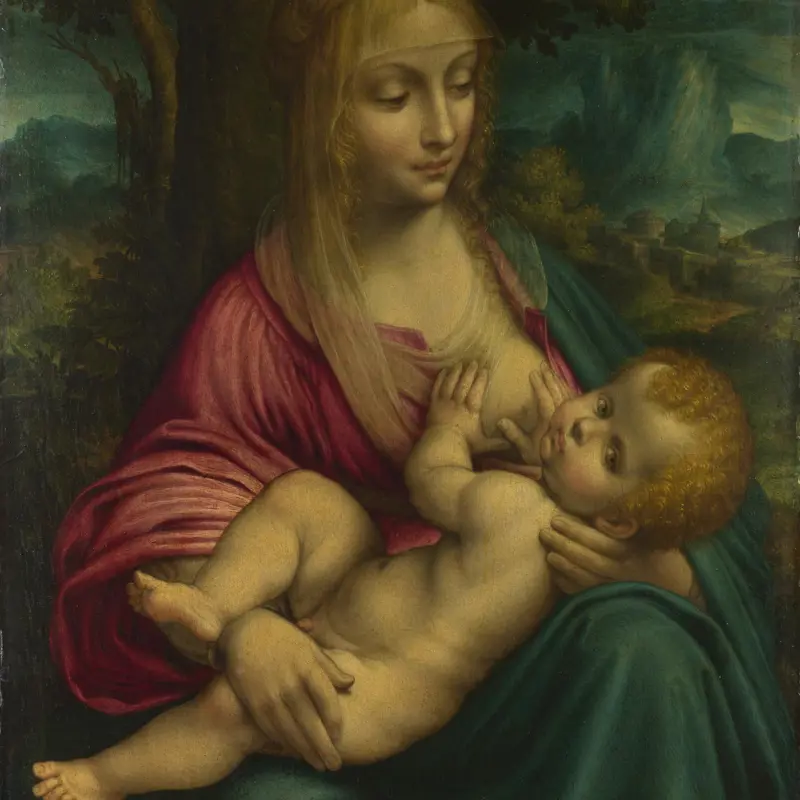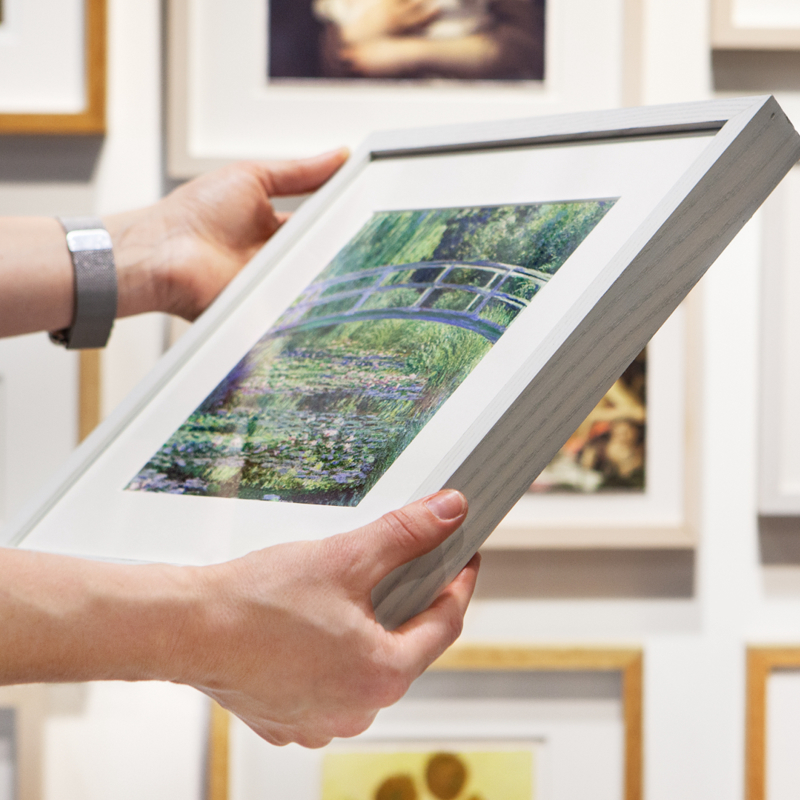Leonardo da Vinci, 'The Burlington House Cartoon', about 1506-8
About the work
Overview
The Virgin Mary sits on her mother’s lap, her attention focused on the wriggling Christ Child. Her mother, Saint Anne, looks intently at her through deep-set eyes and points upwards to the heavens, indicating the child’s divinity. Christ’s cousin, Saint John the Baptist, leans against Anne’s lap as the baby Christ tickles his chin.
This large drawing was made in preparation for a painting, probably as a presentation drawing: a full-sized study of what the planned picture might look like, which could be shown to a patron, or group of patrons. It was, in a sense, intended as a work of art in its own right, unlike other cartoons that were typically used to physically transfer a design of the drawing to the support for painting. Often known as ‘The Burlington House Cartoon’, it is the only surviving large-scale drawing by Leonardo.
Parts of the drawing are densely shaded and contrasted with lighter areas to give a three-dimensional effect, for example the figures’ faces and elements of the draperies such as sections of the Virgin’s sleeve and the folds of fabric which cover Saint Anne’s knees. Other areas, such as the women’s headdresses and feet, and Saint Anne’s pointing hand, are simply indicated with outlines.
Key facts
Details
- Full title
- The Virgin and Child with Saint Anne and the Infant Saint John the Baptist ('The Burlington House Cartoon')
- Artist
- Leonardo da Vinci
- Artist dates
- 1452 - 1519
- Date made
- about 1506-8
- Medium and support
- charcoal with white chalk on paper, mounted on canvas
- Dimensions
- 141.5 × 104.6 cm
- Acquisition credit
- Purchased with a special grant and contributions from the Art Fund, The Pilgrim Trust, and through a public appeal organised by the Art Fund, 1962
- Inventory number
- NG6337
- Location
- Room 51a
- Collection
- Main Collection
- Previous owners
- Frame
- 21st-century Replica Frame
Provenance
Additional information
Text extracted from the ‘Provenance’ section of the catalogue entry in Martin Davies, ‘National Gallery Catalogues: The Earlier Italian Schools’, London 1986 and supplemented by Scott Nethersole and Per Rumberg, ‘Michelangelo, Leonardo, Raphael: Florence, c. 1504’, London 2024 ; for further information, see the full catalogue entry.
Exhibition history
-
2011Leonardo da Vinci: Painter at the Court of MilanThe National Gallery (London)9 November 2011 - 5 February 2012
-
2012La Sainte Anne de Léonard, NapoléonMusée du Louvre29 March 2012 - 25 June 2012
-
2019Léonard de VinciMusée du Louvre24 October 2019 - 24 February 2020
-
2024Michelangelo, Leonardo, Raphael: Florence, circa 1504Royal Academy of Arts9 November 2024 - 16 February 2025
Bibliography
-
1584G.P. Lomazzo, Trattato dell'arte della pittura, Milan 1584
-
1730E. Wright, Some Observations Made in Travelling Through France, Italy, and C., in the Years 1720, 1721 and 1722, London 1730
-
1748Symbolæ litterariæ, opuscula varia philologica, scientifica, antiquaria, signa, lapides, numismata, gemmas, et monumenta Medii Ævi nunc primum edita complectentes, 1625, Florence 1748
-
1757G.G. Bottari, Raccolta di lettere sulla pittura, scultura ed architettura: Scritte da' più celebri personaggi che in dette arti fiorirono dal secolo XV, 6 vols, Rome 1757
-
1758C.-N. Cochin, II, Voyage d'italie, Paris 1758
-
1762Venice, Museo Civico Correr, Mss. PD C 2193.I/II/VII: Inventario E Stima Delli Quadri Esistenti Nel Palazzo Dominical di Ca' Sagredo a S. Sofia. 1762. 15 Giugno, 1762
-
1765P. Monti, Storia genuina del cenacolo insigne dipinto da Leonardo da Vinci nel refettorio de' padri domenicani di Santa Maria delle Grazie di Milano, Milan 1765
-
1778C. Rogers, A Collection of Prints in Imitation of Drawings, London 1778
-
1810G. Bossi, Dal Cenacolo di Leonardo da Vinci, Milan 1810
-
1828J.W. Brown, The Life of Leonardo da Vinci, London 1828
-
1833J.D. Passavant, Kunstreise durch England und Belgien, Frankfurt am Main 1833
-
1836A. Guillon de Montléon, De quatre tableaux attribués à Léonard de Vinci, Paris 1836
-
1836J.D. Passavant, Tour of a German Artist in England, London 1836
-
1838G.F. Waagen, Works of Art and Artists in England, trans. H. Lloyd, vol. 2, London 1838
-
1845A. Ademollo, Marietta de' Ricci, ovvero Firenze al tempo dell'assedio, Florence 1845
-
1849M.J. Rigollot, Catalogue de l'oeuvre de Leonard de Vinci, Paris 1849
-
1854G.F. Waagen, Treasures of Art in Great Britain: Being and Account of the Chief Collections of Paintings, Drawings, Sculptures, Illuminated Mss. […], vol. 2, trans. E. Eastlake, London 1854
-
1855British Institution, Catalogue of Pictures by Italian, Spanish, Flemish, Dutch, French and English Masters, with which the Proprietors have Favoured the Institution, London 1855
-
1873W. Pater, Studies in the Art of the Renaissance, London 1873
-
1878G. Vasari, Le vite de'più eccellenti pittori, scultori ed architettori: Con nuove annotazioni e commenti di Gaetano Milanesi, ed. G. Milanesi, 8 vols, Florence 1878
-
1896Royal Academy of Arts, Exhibition of the Works of the Old Masters (exh. cat. Royal Academy of Arts, 1896), London 1896
-
1897H.F. Cook, 'Trésors de l'art italien en Angleterre: Le carton de Léonard de Vinci à la Royal Academy', Gazette des beaux-arts, VIII, 1897
-
1899L.H. Heydenreich, 'La Sainte Anne de Leonard da Vinci', Gazette des beaux-arts, X, 1899, pp. 205-19
-
1903H. Horne, The Life of Leonardo da Vinci by Giorgio Vasari, London 1903
-
1903A. MacLeod, 'The St Anna Cartoon of Leonardo da Vinci', Art Journal, 1903, pp. 295-300
-
1903B. Berenson, 'Leonardo da Vinci', in B. Berenson, The Study and Criticism of Italian Art, London 1903, pp. 1-37
-
1909W. von Seidlitz, Leonardo da Vinci, Berlin 1909
-
1911L. Beltrami, Luini 1512-1532: Materiale di studio, Milan 1911
-
1912H.F. Cook, 'Notes on Leonardo da Vinci: I. The Royal Academy Cartoon', in H.F. Cook, Reviews and Appreciations of some Old Italian Masters, London 1912, pp. 1-21
-
1919G. Poggi, La vita di Giorgio Vasari, Florence 1919
-
1920Burlington Fine Arts Club, Catalogue of an Exhibition of Florentine Painting before 1500, London 1920
-
1925J. Shapley, 'A Lost Cartoon for Leonardo's Madonna with Saint Anne', Art Bulletin, VII/3, 1925, pp. 96-102
-
1928A.D. Popp, Leonardo da Vinci: Zeichnungen, Munich 1928
-
1928O. Sirén, Leonardo da Vinci: L'artiste et l'homme, Paris 1928
-
1928E. Moeller, 'Die Madonna mit den spielenden Kindern aus der Werkstatt Leonardos', Zeitschrift für bildende Kunst, LXII, 1928, pp. 217-25
-
1930T. Borenius, 'Leonardo's Madonna with the Children at Play', The Burlington Magazine, LVI/324, 1930, pp. 142-7
-
1931H. Bodmer, Leonardo, Stuttgart 1931
-
1935K. Clark, A Catalogue of the Drawings of Leonardo Da Vinci in the Collection of His Majesty the King at Windsor Castle, Cambridge 1935
-
1938B. Berenson, 'Leonardo da Vinci', in B. Berenson, The Drawings of the Florentine Painters, Chicago 1938
-
1939K. Clark, Leonardo da Vinci: An Account of His Development as an Artist, Cambridge 1939
-
1944R.L. Douglas, Leonardo da Vinci: His Life and His Writings, Chicago 1944
-
1945L. Goldscheider, Leonardo da Vinci, Oxford 1945
-
1946A.E. Popham, The Drawings of Leonardo da Vinci, London 1946
-
1947A.E. Popham, The Drawings of Leonardo Da Vinci, 2nd edn, London 1947
-
1950A.E. Popham and P. Pouncey, Italian Drawings in the Department of Prints and Drawings in the British Museum: The Fourteenth and Fifteenth Centuries, London 1950
-
1951C. Pedretti, Leonardo da Vinci e il poeta bolognese Gerolamo Pandolfi da Casio de' Medici, Bologna 1951
-
1951M. Brunetti, 'Un eccezionale collegio peritale: Piazzetta, Tiepolo, Longhi', Arte veneta, 1951, pp. 158-60
-
1951M.A. Lavin, 'A New Facet of Leonardo's Working Procedure', Art Bulletin, XXXIII, 1951, pp. 235-9
-
1952K.D. Keele, Leonardo da Vinci Quincentenary Exhibition (exh. cat. Royal Academy of Arts, 1952), London 1952
-
1955M.A. Lavin, 'Giovannino Battista: A Study in Renaissance Religious Symbolism', Art Bulletin, XXXVII/2, 1955, pp. 85-101
-
1956G. Castelfranco, La pittura di Leonardo, Rome 1956
-
1957S. Freud, 'Leonardo da Vinci and a Memory of his Childhood', in S. Freud, The Standard Edition of the Complete Psychological Works of Sigmund Freud (Five Lectures on Psycho-Analysis, Leonardo da Vinci, and other Works), London, 1957, vol. 11, pp. 63-137
-
1961K. Clark, Leonardo da Vinci, Cambridge 1961
-
1962P. Murray, 'The Leonardo Cartoon', British Journal of Aesthetics, II/3, 1962
-
1962J.B. Shaw, 'One Link More in the History of the Leonardo Cartoon', The Burlington Magazine, CIV/710, 1962, pp. 212-3
-
1963National Gallery, Acquisitions 1953-62, National Gallery Catalogues, London 1963
-
1965The National Gallery, The National Gallery: June 1962 - December 1964, London 1965
-
1966W. Pater, Leonardo da Vinci, Bristol 1966
-
1967A. Ottino della Chiesa, L'opera completa di Leonardo, Milan 1967
-
1968K. Clark and C. Pedretti, The Drawings of Leonardo Da Vinci in the Collection of Her Majesty the Queen at Windsor Castle, London 1968
-
1968C. Pedretti, 'The Burlington House Cartoon', The Burlington Magazine, CX/778, 1968, pp. 22-8
-
1968A. Schug, 'Zur Ikonographie von Leonardos Londoner Karton', Pantheon, XXVI, 1968, pp. 446-55
-
1969J. Wassermann, 'Michelangelo's Virgin and Child with Saint Anne, at Oxford', The Burlington Magazine, CXI/792, 1969, pp. 122-34
-
1970J. Wassermann, 'A Re-Discovered Cartoon by Leonardo da Vinci', The Burlington Magazine, CXII/805, 1970, pp. 194-204
-
1971J. Wassermann, 'The Dating and Patronage of Leonardo's Burlington House Cartoon', Art Bulletin, LIII, 1971, pp. 312-25
-
1973H. Tanaka, 'Una nuova analisi sulla Sant'Anna e sul San Giovanni di Leonardo da Vinci', Istituto Giapponese di Cultura, XI, 1973, pp. 85-101
-
1974A.J. Diamond, Cardinal Federico Borromeo as a Patron and Critic of the Arts and his Musaeum of 1625, Ann Arbor 1974
-
1974C. Pedretti, 'La "Femme échevelée" de Léonard de Vinci', Revue de l'art, XXV, 1974, pp. 24-34
-
1974A.M. Brizio, 'Leonardo pittore', in L. Reti (ed.), Leonardo, Milan 1974, pp. 20-55
-
1975C. Gould, Leonardo, the Artist and the Non-Artist, London 1975
-
1975B.H. Meyer, 'Louis XII, Leonardo and the Burlington House Cartoon (six Letters, 1507)', Gazette des beaux-arts, LXXXVI/1281, 1975, pp. 105-9
-
1978C. Gould, The Draped Figure, Themes and Painters in the National Gallery 2, 2nd edn, London 1978
-
1978E. Pogány-Balás, 'Antique Sources of Draped Figures in Leonardo's Nudes', Acta historiae artium, XXIV/1-4, 1978, pp. 189-94
-
1979V. Budny, 'The Poses of the Child in Composition Sketches by Leonardo da Vinci for the Madonna and Child with a Cat', Weatherspoon Gallery Association Bulletin, 1979, pp. 5-12
-
1981M. Kemp, Leonardo da Vinci. The Marvellous Work of Nature and Man, London 1981
-
1981G. Rosenthal, Italian Paintings XIV-XVII Centuries, from the Collection of the Baltimore Museum of Art, Baltimore 1981
-
1981P. Leighten, 'Leonardo's Burlington House Cartoon', Rutgers Art Review, II, 1981, pp. 31-42
-
1982D.A. Brown, 'Correggio's Mystic Marriage of Saint Catherine and Its Sources', Bulletin of the Detroit Institute of Arts, LX/43193, 1982, pp. 100-7
-
1982D. Sutton, 'Aspects of British Collecting, II.VI: Cross-Currents in Taste', Apollo, CXVI/250, 1982, pp. 373-89
-
1982C. Pedretti (ed.), Leonardo dopo Milano: La Madonna dei Fusi (exh. cat. Castello dei conti Guidi, 16 May - 30 September 1982), Florence 1982
-
1982D. Arasse, 'Note sur le Sainte Anne', in Symboles de la Renaissance: Second volume, Paris 1982, pp. 71-87
-
1983S. Béguin, Leonardo da Vinci au Louvre, Paris 1983
-
1983V. Budny, 'The Sequence of Leonardo's Sketches for the Virgin and Child with Saint Anne and Saint John the Baptist', Art Bulletin, LXV, 1983, pp. 34-49
-
1984L. Steinberg, The Sexuality of Christ in Renaissance Art and Modern Oblivion, London 1984
-
1984C. Gould, 'Drawing into Painting: Raphael's Use of His Studies', Apollo, CXIX/263, 1984, pp. 8-15
-
1986Davies, Martin, National Gallery Catalogues: The Earlier Italian Schools, revised edn, London 1986
-
1986K.H. Vettmann, Linear Perspective and Its Visual Dimensions of Science and Art, Studies on Leonardo da Vinci 1, Munich 1986
-
1986S. Wegner, Images of Madonna and Child by Three Tuscan Artists of the Early Seicento: Vanni, Roncalli and Manetti, Brunswick 1986
-
1986F. Hartt, 'Leonardo and the Second Florentine Republic', Journal of the Walters Art Gallery, XLIV, 1986, pp. 373-89
-
1987'The Leonardo Cartoon', The Burlington Magazine, CXXIX/1014, 1987, p. 571
-
1988U. Baldini, Leonardo: Tutta la pittura, Florence 1988
-
1989National Gallery, The National Gallery Report: January 1988 - March 1989, London 1989
-
1989F. Ames-Lewis (ed.), Nine Lectures on Leonardo da Vinci, London 1989
-
1989P.C. Marani, Leonardo, catalogo completo dei dipinti, Florence 1989
-
1989E. Harding et al., 'The Restoration of the Leonardo Cartoon', National Gallery Technical Bulletin, XIII, 1989, pp. 4-27
-
1989M. Kemp, Leonardo da Vinci: Scientist, Inventor, Artist (exh. cat. Hayward Gallery, 1989), New Haven 1989
-
1991M. Keynes, 'The Iconography of Leonardo's London Cartoon', Gazette des beaux-arts, CXVII, 1991, pp. 147-58
-
1991C. Pedretti, 'Leonardo and the Antique', Achademia Leonardi Vinci: Journal of Leonardo Studies and Bibliography of Vinciana, IV, 1991, pp. 214-43
-
1991J. Shell and G. Sironi, 'Document for the History of Collecting: II. Salai and Leonardo's Legacy', The Burlington Magazine, CXIII/1055, 1991, pp. 95-108
-
1992A. Green, Révélations de l'inachèvement: À propos du carton de Londres du Léonard de Vinci, Paris 1992
-
1992S. Hager (ed.), Leonardo, Michelangelo, and Raphael in Renaissance Florence from 1500 to 1508. Papers from a Symposium Sponsored by Georgetown University and Held at the Charles Augustus Strong Center at Villa Le Balze in Fiesole, Italy on June 14, 1989., Washington, D.C. 1992
-
1992P. Johannides, 'Creative Distorsions in the Renaissance: Lippi, Leonardo and Parmigianino', Apollo, CXXXVI/368, 1992, pp. 239-46
-
1992E. Harding, 'The Leonardo Cartoon', in A. Oddy (ed.), The Art of the Conservator, London 1992, pp. 28-41
-
1992M. Clayton, 'Studi per Sant'Anna', in Palazzo Grassi, Leonardo e Venezia, Milan 1992, pp. 242-54
-
1993P.M. Jones, Federico Borromeo and the Ambrosiana: Art Patronage and Reform in 17th-Century Milan, Cambridge 1993
-
1993P. Emison, 'Leonardo's Landscape in the Virgin of the Rocks', Zeitschrift für Kunstgeschichte, LVI/1, 1993, pp. 116-8
-
1994J.-P.M. Gerard, Léonard de Vinci: Mithologie ou théologie, Paris 1994
-
1994M. Schapiro, Theory and Philosophy of Art, New York 1994
-
1994A.R. Turner, Inventing Leonardo, Berkeley 1994
-
1995P.C. Marani, 'Tivoli, Hadrian and Antinoüs: New Evidence of Leonardo's Relation to the Antique', Achademia Leonardi Vinci: Journal of Leonardo Studies and Bibliography of Vinciana, VIII, 1995, pp. 207-25
-
1995A.W.G. Posèq, 'A "Mithraic Formula" in Renaissance Images of the Christ Child', Konsthistorisk Tidskrift, LXIV/4, 1995, pp. 204-14
-
1996M. Clayton, Leonardo da Vinci: A Curious Vision, London 1996
-
1996J. Cox-Rearick, The Collection of Francis I: Royal Treasures, New York 1996
-
1996M.A. Holly, Past Looking: Historical Imagination and the Rhetoric of the Image, Ithaca 1996
-
1996F. Pesci, 'Il mito di Leonardo nella storiografia rinascimentale dell'Ottocento. Nuovi percorsi alle fonti della cultura simbolista francese', Storia dell'arte, LXXXVII, 1996, pp. 260-85
-
1997C. Pedretti, 'The Arconati Cartoon', Achademia Leonardi Vinci: Journal of Leonardo Studies and Bibliography of Vinciana, X, 1997, pp. 239-41
-
1997A.W.G. Posèq, 'Left and Right in Leonardo', Konsthistorisk Tidskrift, LXVI/1, 1997, pp. 37-50
-
1997C. Del Bravo, 'Qualche parola su Leonardo', in Scritti per l'Istituto germanico di storia dell'arte di Firenze, Florence 1997, pp. 183-8
-
1999C.C. Bambach, Drawing and Painting in the Italian Renaissance Workshop: Theory and Practice, 1300-1600, Cambridge 1999
-
1999C. Farago (ed.), Biography and Early Art Criticism of Leonardo da Vinci, New York 1999
-
1999C. Farago (ed.), An Overview of Leonardo's Career and Projects Until c.1500, New York 1999
-
1999P.C. Marani, Leonardo: Una carriera di pittore, Milan 1999
-
1999R. Zwijnenberg, The Writings and Drawings of Leonardo da Vinci: Order and Chaos in Early Modern Thought, New York 1999
-
1999R. Goffen, 'Mary's Motherhood According to Leonardo and Michelangelo', Artibus et historiae, XX/40, 1999, pp. 35-69
-
1999P.C. Marani, 'Classical Masterpiece', Art Quarterly, 1999, pp. 44-7
-
2000V. Forrester, Au Louvre avec Viviane Forrester: La vierge à l'enfant avec Sainte-Anne de Léonard de Vinci 1452-1519, Paris 2000
-
2000P.C. Marani (ed.), Hostinato rigore. Leonardiana in memoria di Augusto Marinoni, Milan 2000
-
2000R. Maniura, 'Voting with their Feet: Art, Pilgrimage and Ratings in the Renaissance', in G. Neher and R. Shepherd (eds), Revaluing Renaissance Art, Aldershot 2000, pp. 187-99
-
2001
C. Baker and T. Henry, The National Gallery: Complete Illustrated Catalogue, London 2001
-
2003M.T. Fiorio and V. Terraroli, Lombardia rinascimentale: Arte e architettura, Milan 2003
-
2003F. Zöllner, Leonardo da Vinci, 1452-1519: The Complete Paintings and Drawings, Cologne 2003
-
2003K.H. Di Dio, 'Leone Leoni's Collection in the Casa Degli Omenoni, Milan: The Inventory of 1609', The Burlington Magazine, CXLV/1205, 2003, pp. 572-8
-
2003C.C. Bambach, Leonardo da Vinci (exh. cat. Metropolitan Museum of Art, 22 January - 30 March 2003), New York 2003
-
2004J.O. Hand, Joos Van Cleve: The Complete Paintings, New Haven 2004
-
2004C.C. Bambach, 'Leonardo and Drapery Studies on "tela sottilissima di lino"', Apollo, CLIX/503, 2004, pp. 44-55
-
2004P.M. Jones, 'Italian Devotional Paintings and Flemish Landscapes in the Quadrerie of Cardinals Giustiniani, Borromeo, and del Monte', Storia dell'arte, CVII/7, 2004, pp. 81-104
-
2004H. Chapman, T. Henry and C. Plazzotta, Raphael: From Urbino to Rome (exh. cat. The National Gallery, 20 October 2004 - 16 January 2005), London 2004
-
2005V. Arrighi, A. Bellinazzi and E. Villata, Leonardo da Vinci: La vera imagine. Documenti e testimonianze sulla vita e sull'opera (exh. cat. Archivio di Stato di Firenze, 19 October 2005 - 28 January 2006), Florence 2005
-
2008E. Shanes, 'More Art on the Line: The Royal Academy's Antique Room in the Exhibition of 1792', The Burlington Magazine, CL/1261, 2008, pp. 224-31
-
2008R. Hiller von Gaertringen, 'On the Question of Spontaneity and Improvisation in the Working Procedures of Early Italian Panel Painters: Some Examples', in F. Pasut and J. Trippss (eds), Da Giotto a Botticelli: Pittura fiorentina tra Gotico e Rinascimento, Florence 2008, pp. 201-24
About this record
If you know more about this work or have spotted an error, please contact us. Please note that exhibition histories are listed from 2009 onwards. Bibliographies may not be complete; more comprehensive information is available in the National Gallery Library.




